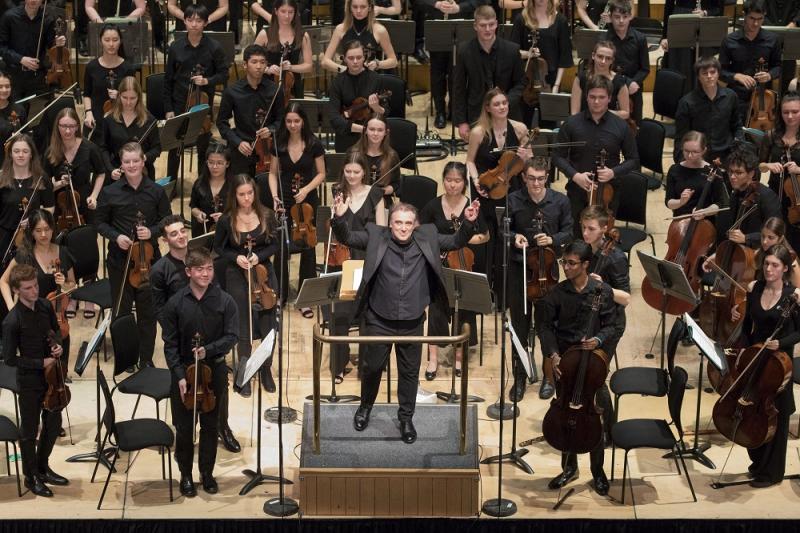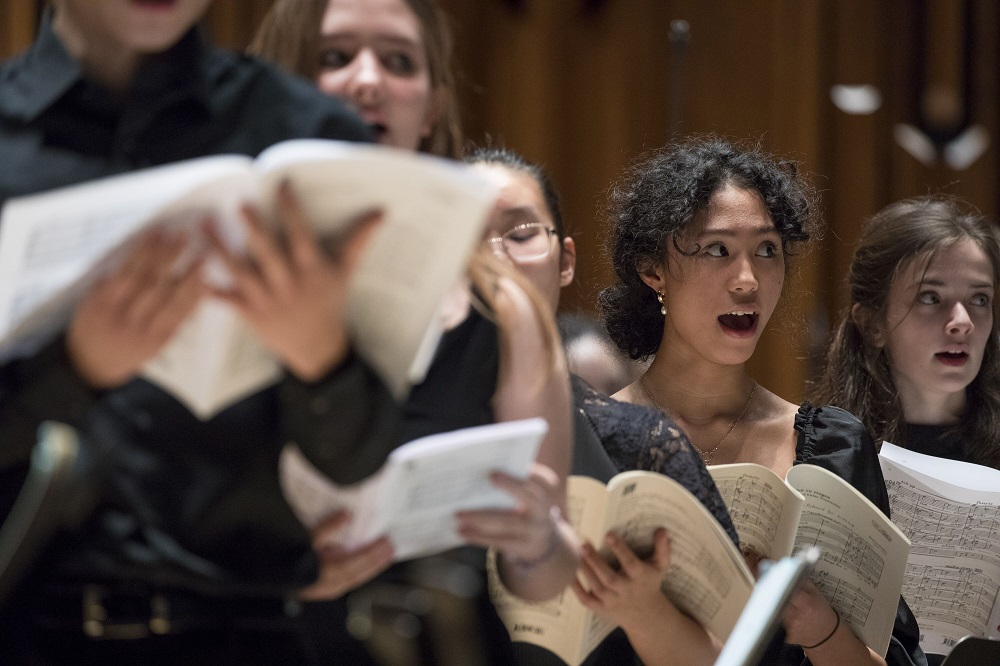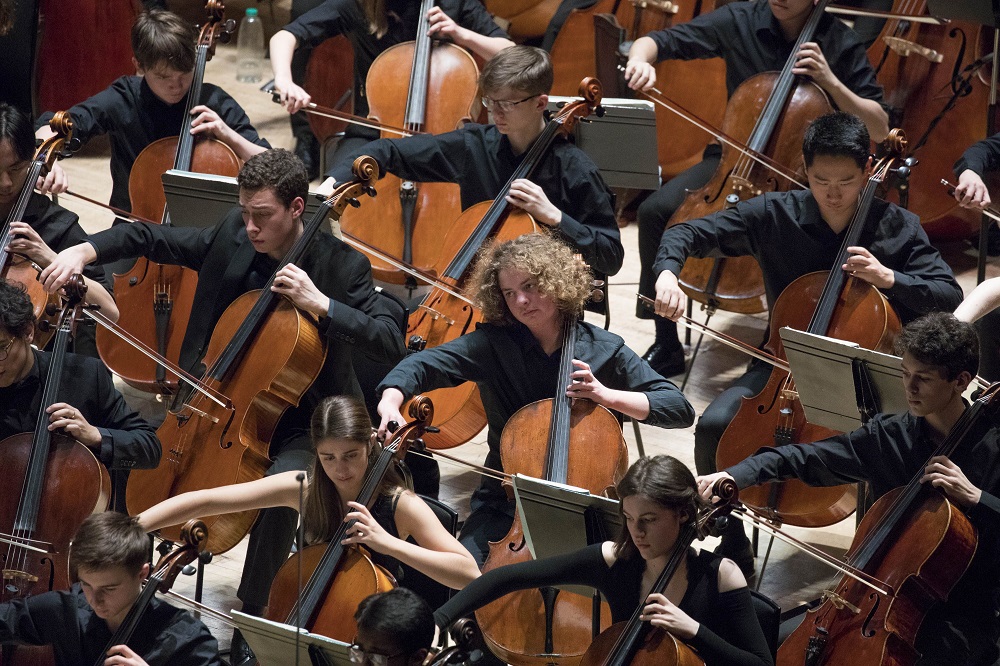National Youth Orchestra of Great Britain, Martín, Barbican review - songs of protest and resilience | reviews, news & interviews
National Youth Orchestra of Great Britain, Martín, Barbican review - songs of protest and resilience
National Youth Orchestra of Great Britain, Martín, Barbican review - songs of protest and resilience
Singing phrases carry huge emotion as 164 teenagers make their voices heard

In youth we trust. That can be the only motto worth anything for 2020, as the world goes into further meltdown.
So it was startling, stunning and cathartic, two days after the big downer of 3 January – the American horror clown seemingly in competition with the Australian apocalypse – to witness 164 teenagers under a conductor they clearly adore, Jaime Martín, making their voices heard, sometimes literally, in 20th century music of fear, anxiety, protest, violence and just a smidgen of hope.
Britten's Sinfonia da Requiem, short though it is in time-span, has long been overlooked as one of the great symphonies; Shostakovich's Eleventh is more of a symphonic poem in cinemascope, full of late 19th and early 20th century revolutionary songs which I used to think diminished its substance. Not, though, when you hear them sung before and between movements.
A mature student of mine and dear friend, Trude Winik, who died at the age of 87, surprised me by declaring the Eleventh her favourite Shostakovich symphony. Why? Because its slow movement takes the theme of a memorial anthem which she used to sing in "our red Vienna" as "Unsterbliche Opfer", "Immortal Sacrifice". In last night's performance, since it is quoted in full by the violas, it was left unsung, in literal terms at least – until we got to the encore, the only possible one.  It could have been Britten's Russian Funeral, which also pays homage to this powerful melody, but instead the young musicians delivered the original as they had Eisler's "Demonstration Song" Auf den Strassen zu singen (We are singing in the streets, some of the performers pictured above), "Listen!", the revolutionary song, to preface its appearance in Shostakovich's "Palace Square" opener depicting the frozen Petersburg scene on 9 January 1905, "Bare your heads" fading away – goosebump time – before the whirlwinds of the second movement and a final song of defiance before the struggles and warnings of "Tocsin". Choral auditions can't have been part of the admission process to the NYO, but how artistically they delivered every number.
It could have been Britten's Russian Funeral, which also pays homage to this powerful melody, but instead the young musicians delivered the original as they had Eisler's "Demonstration Song" Auf den Strassen zu singen (We are singing in the streets, some of the performers pictured above), "Listen!", the revolutionary song, to preface its appearance in Shostakovich's "Palace Square" opener depicting the frozen Petersburg scene on 9 January 1905, "Bare your heads" fading away – goosebump time – before the whirlwinds of the second movement and a final song of defiance before the struggles and warnings of "Tocsin". Choral auditions can't have been part of the admission process to the NYO, but how artistically they delivered every number.
All this, with input from composer and Russian music expert Gerard McBurney, immeasurably enriched the Shostakovich narrative, so sensitively stitched in that it could become a regular feature. But the interpretation was magnificent and white-heat in itself, the massacre taken by Martín at lightning speed, the incredible strings digging into their protest music and pulling out the major-key transformation of "Bare your heads" with such emotion that I shed tears for the first time ever in this difficult conclusion. How amazing it is, though, that Shostakovich does not follow the usual Soviet darkness-struggle-victory trajectory, that he ends with alarm bells warning how history repeats itself (as it just had in the Budapest uprising). You could do this sort of thing in 1957, not – as the composer learnt so frighteningly – during Stalin's time.
Is it fanciful to suggest that the group singing had informed the phrasing? Britten's agonised wide intervals in his opening "Lacrymosa" were gilded with pathos in the violins' portamenti, so vocal that if you'd been steeped in the last operatic masterpiece, Death in Venice, you'd realise that the composer carried them forward to the cries of "Adziu" three and a half decades later. Encouraging players "to do a phrase in a way that might not be their initial instinct" is in Martín's manifesto. As a flautist who played under Abbado in the European Union Youth Orchestra before going on to hold posts at ENO and the LPO, among others, he knows how it works from both sides.  This was a performance of depth rather than acid bite, though the splinterings of the Boschian "Dies Irae" were perfectly together. And then the tentative healing, when "through the black mud first the wheat/In shy green stalks appears", to quote lines from the Auden poem Britten partly set in his Spring Symphony: so expressive, so well contained. Indeed, the treacherous amplifying acoustics of the Barbican did not betray these players; though a member of the NYO's admin brought earplugs for the Shostakovich, they weren't needed. The overwhelming impression was one of beauty of tone at most times, definition and perspective in the welters. A worthy successor indeed to my top concert of 2019, the NYO's Prom with Mark Wigglesworth conducting and violinist Nicola Benedetti.
This was a performance of depth rather than acid bite, though the splinterings of the Boschian "Dies Irae" were perfectly together. And then the tentative healing, when "through the black mud first the wheat/In shy green stalks appears", to quote lines from the Auden poem Britten partly set in his Spring Symphony: so expressive, so well contained. Indeed, the treacherous amplifying acoustics of the Barbican did not betray these players; though a member of the NYO's admin brought earplugs for the Shostakovich, they weren't needed. The overwhelming impression was one of beauty of tone at most times, definition and perspective in the welters. A worthy successor indeed to my top concert of 2019, the NYO's Prom with Mark Wigglesworth conducting and violinist Nicola Benedetti.
Too political? These remarkable young people realise it's all political now. Seventeen-year-old leader Kynan Walker is clear in his programme words that "toxic, extreme nationalism" was Eisler's target, that the Britten "conveys his anti-war attitude" (and indeed, the composer said so), that Shostakovich's Eleventh is a "denunciation of violent suppression". On the opposite page, CEO and Artistic Director Sarah Alexander reminds us that "in the face of a music education crisis, tonight's concert is a radical act". Keep on rising up, young musicians. The world is listening.
- To be broadcast on BBC Radio 3 on Monday 13 January
- Programme repeated tonight in Nottingham's Royal Concert Hall
- Next NYO event is Beyond Beethoven 9 at the Southbank Centre, 16-18 April
- More classical reviews on theartsdesk
rating
Explore topics
Share this article
The future of Arts Journalism
You can stop theartsdesk.com closing!
We urgently need financing to survive. Our fundraising drive has thus far raised £49,000 but we need to reach £100,000 or we will be forced to close. Please contribute here: https://gofund.me/c3f6033d
And if you can forward this information to anyone who might assist, we’d be grateful.

Subscribe to theartsdesk.com
Thank you for continuing to read our work on theartsdesk.com. For unlimited access to every article in its entirety, including our archive of more than 15,000 pieces, we're asking for £5 per month or £40 per year. We feel it's a very good deal, and hope you do too.
To take a subscription now simply click here.
And if you're looking for that extra gift for a friend or family member, why not treat them to a theartsdesk.com gift subscription?
more Classical music
 Bizet in 150th anniversary year: rich and rare French offerings from Palazzetto Bru Zane
Specialists in French romantic music unveil a treasure trove both live and on disc
Bizet in 150th anniversary year: rich and rare French offerings from Palazzetto Bru Zane
Specialists in French romantic music unveil a treasure trove both live and on disc
 Scottish Chamber Orchestra, Ibragimova, Queen’s Hall, Edinburgh review - rarities, novelties and drumrolls
A pity the SCO didn't pick a better showcase for a shining guest artist
Scottish Chamber Orchestra, Ibragimova, Queen’s Hall, Edinburgh review - rarities, novelties and drumrolls
A pity the SCO didn't pick a better showcase for a shining guest artist
 Kilsby, Parkes, Sinfonia of London, Wilson, Barbican review - string things zing and sing in expert hands
British masterpieces for strings plus other-worldly tenor and horn - and a muscular rarity
Kilsby, Parkes, Sinfonia of London, Wilson, Barbican review - string things zing and sing in expert hands
British masterpieces for strings plus other-worldly tenor and horn - and a muscular rarity
 From Historical to Hip-Hop, Classically Black Music Festival, Kings Place review - a cluster of impressive stars for the future
From quasi-Mozartian elegance to the gritty humour of a kitchen inspection
From Historical to Hip-Hop, Classically Black Music Festival, Kings Place review - a cluster of impressive stars for the future
From quasi-Mozartian elegance to the gritty humour of a kitchen inspection
 Shibe, LSO, Adès, Barbican review - gaudy and glorious new music alongside serene Sibelius
Adès’s passion makes persuasive case for the music he loves, both new and old
Shibe, LSO, Adès, Barbican review - gaudy and glorious new music alongside serene Sibelius
Adès’s passion makes persuasive case for the music he loves, both new and old
 Anja Mittermüller, Richard Fu, Wigmore Hall review - a glorious hall debut
The Austrian mezzo shines - at the age of 22
Anja Mittermüller, Richard Fu, Wigmore Hall review - a glorious hall debut
The Austrian mezzo shines - at the age of 22
 First Person: clarinettist Oliver Pashley on the new horizons of The Hermes Experiment's latest album
Compositions by members of this unusual quartet feature for the first time
First Person: clarinettist Oliver Pashley on the new horizons of The Hermes Experiment's latest album
Compositions by members of this unusual quartet feature for the first time
 Gesualdo Passione, Les Arts Florissants, Amala Dior Company, Barbican review - inspired collaboration excavates the music's humanity
At times it was like watching an anarchic religious procession
Gesualdo Passione, Les Arts Florissants, Amala Dior Company, Barbican review - inspired collaboration excavates the music's humanity
At times it was like watching an anarchic religious procession
 Classical CDs: Camels, concrete and cabaret
An influential American composer's 90th birthday box, plus British piano concertos and a father-and-son duo
Classical CDs: Camels, concrete and cabaret
An influential American composer's 90th birthday box, plus British piano concertos and a father-and-son duo
 Cockerham, Manchester Camerata, Sheen, Martin Harris Centre, Manchester review - re-enacting the dawn of modernism
Two UK premieres added to three miniatures from a seminal event of January 1914
Cockerham, Manchester Camerata, Sheen, Martin Harris Centre, Manchester review - re-enacting the dawn of modernism
Two UK premieres added to three miniatures from a seminal event of January 1914
 Kempf, Brno Philharmonic, Davies, Bridgewater Hall, Manchester review - European tradition meets American jazz
Bouncing Czechs enjoy their Gershwin and Brubeck alongside Janáček and Dvořák
Kempf, Brno Philharmonic, Davies, Bridgewater Hall, Manchester review - European tradition meets American jazz
Bouncing Czechs enjoy their Gershwin and Brubeck alongside Janáček and Dvořák
 Solomon, OAE, Butt, QEH review - daft Biblical whitewashing with great choruses
Even a top soprano and mezzo can’t make this Handel paean wholly convincing
Solomon, OAE, Butt, QEH review - daft Biblical whitewashing with great choruses
Even a top soprano and mezzo can’t make this Handel paean wholly convincing

Add comment